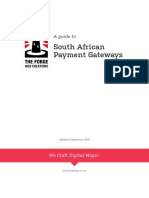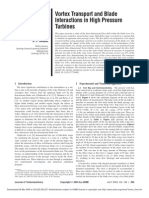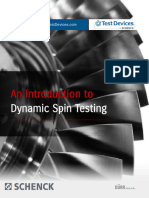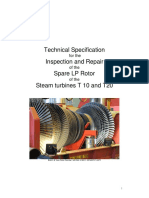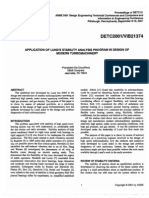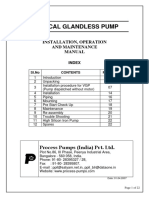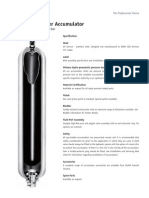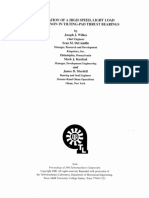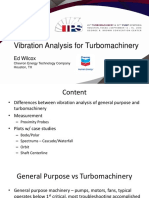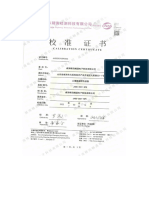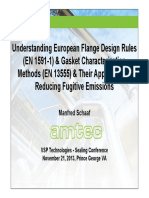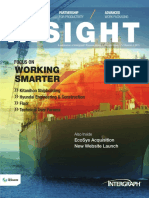Ch15 Taylor
Ch15 Taylor
Uploaded by
ramnadh803181Copyright:
Available Formats
Ch15 Taylor
Ch15 Taylor
Uploaded by
ramnadh803181Original Description:
Copyright
Available Formats
Share this document
Did you find this document useful?
Is this content inappropriate?
Copyright:
Available Formats
Ch15 Taylor
Ch15 Taylor
Uploaded by
ramnadh803181Copyright:
Available Formats
Scott L.
Taylor is a Senior Staff Engineer within the Steam
Turbine Systems Engineering group at Woodward, in Fort Collins,
Colorado. His expertise is in rotating machinery control systems,
which includes development work on new technology gas and
steam turbine controls. He has significant field and international
experience and has been responsible for coordinating engineering
groups and projects across international organizations. Mr. Taylor
has previously worked for controls divisions at GE and Wood Group.
Mr. Taylor received his B.S. degree (Electrical Engineering,
1987) from Colorado State University.
Sheldon S. Smith is a Senior Controls Engineer with American
Electric Power (AEP), in Carrollton, Texas. He has been responsible
for areas of controls modernization, turbine controls systems
retrofits, and emissions monitoring and reporting throughout their
southwestern fleet. He has worked in many facets of process
control and engineering elsewhere spanning the aluminum
industry at ALCOA and Kaiser and the continuous emissions
monitoring sector at Odessa Engineering.
Mr. Smith received a B.S. degree (Aerospace Engineering, 1990)
from Texas A&M University and a B.S. degree (Metallurgical &
Material Science, 1991) from University of Texas El Paso.
ABSTRACT
Turbine overspeed events lead to the most dangerous and costly
of catastrophic turbine failures. Traditionally, overspeed protection
systems were designed and provided by the original equipment
manufacturers (OEMs)few options were available either in terms
of testing or modifying these systems. With new turbines, and with
the retrofit of older systems, it is more common to see third party
systems playing this critical protective role. However users often
do not appreciate the overspeed protection system response time
that is required to adequately protect their equipment.
This tutorial will explain the basic components of a turbine trip
system, and consider sources of variability in the response times of
those components. Industry standards, API 612 (2005) and API
670 (2000), will be used to show how to calculate the required
overspeed protection system response time. Users will walk out of
this tutorial with a basic understanding of what comprises a steam
turbine trip system, a greater appreciation of the affect of the
system response time, and an understanding of how to verify that
their system has the adequate response time to protect their
turbines, plants, and personnel.
INTRODUCTION
A turbine overspeed event can lead to catastrophic failures that
may generate unanticipated, uncontained liberation of turbine
blades and components, release high pressure and temperature
steam, and result in secondary damage including process piping
damage, chemical release, fires, and missile damage. Its causes
and prevention are common topics of presentations, articles, sales
brochures, as well discussions with operators, societies, manufacturers,
and insurance carriers.
New technology has brought solutions to some of the shortcomings
of traditional mechanical protection mechanisms and brought a
host of new possibilities, choices, and potential problems with
overspeed protection systems. It has also brought the possibility to
better understand, analyze, and measure the performance needed
and delivered by protection systems. Industry guidelines are being
expanded to incorporate the new technologies as well as the need
to increase the owner/operators understanding of their system. The
newest challenge facing owners and operators is understanding the
response requirements of their systems and the testing that is
required to assure the system is adequately protected.
This tutorial will present the traditional protection means, the
new systems, guidelines for system designs that exist today, and new
information that is being added. The authors will look at these new
guidelines in detail and provide examples of several different
systems. This tutorial will use industrial standards, API 612 (2005)
and 670 (2000), to assist with educating turbine users on specific
timing requirements and testing necessary to safely protect their
turbines and their driven loads. Since the entire steam turbine trip
system must respond fast enough to safely protect the turbine and its
driven load (compressor, generator, pump), the timing of each basic
trip system component will be reviewed. The authors will break
down the components of the total system that determine the
magnitude of an overspeed event. They will also discuss some of the
testing options and tradeoffs that are now available. One objective is
to demonstrate how to calculate and verify the required component
response times based on the required total system trip time.
It is becoming common to find steam turbines that have been or
are being upgraded with new controls and/or related shutdown
systems. This tutorial will focus on what turbine response times are
required to adequately protect turbines of all sizes. Examples based
on real turbines will be used to compare the differences between
turbine shutdown systems scan rates and response times.
Cost and in some cases the recommendations of OEMs may
encourage the adoption of different test methodologies. Since
testing of these trip systems has become a large discussion topic
throughout the Turbomachinery Laboratorys Turbomachinery
Symposiums discussion groups, basic testing procedures will be
compared in an effort to educate users on best practices.
MECHANICAL OVERSPEED SENSING SYSTEMS
Traditional mechanical overspeed sensing systems relied on the
balance between the centripetal force imparted on a weight by the
rotation of the shaft opposed to a spring with a known and specific
constant. At the designed overspeed trip point, this balance position
157
TURBINE OVERSPEED SYSTEMS AND REQUIRED RESPONSE TIMES
by
Scott L. Taylor
Senior Staff Engineer
Woodward
Fort Collins, Colorado
and
Sheldon S. Smith
Senior Controls Engineer
American Electric Power
Carrollton, Texas
Table of Contents
of this weight allows it to physically contact with a lever that
releases a valve that causes the trip oil header to drain and lose
pressure. The spring, bolt, and trip lever can be seen in Figure 1.
Figure 1. Mechanical Overspeed Trip Mechanism Photo. (Courtesy
Younie, 2009)
Figure 2 does not show manual trips or trip overrides for testing
purposes that are associated with this system but, essentially there
is a direct, if complex, mechanical connection between the trip bolt
and the trip oil header dump valve.
Figure 2. Mechanical Overspeed Trip System Schematic (Simplified).
The loss of trip oil header pressure may directly move a trip
mechanism or may operate through a hydraulic circuit to cause
stop valves to close. In general, the trip oil system follows a
common design regardless of the sensing mechanism although the
trip mechanism designs on the steam valve can vary. The trip
systems will be described in more detail later.
Since the mechanism is not easily observed, it is possible for a
significant problem to go undetected. The author is familiar with a
case where the assembly was built incorrectly but the system
appeared to function properly for years (the bolt was not striking the
trip lever in the correct location). The risk of the failure was arguably
higher because the system was not operating as it was designed to.
On many systems there is only a single bolt. Because the contact
with the lever occurs over a relatively limited angle there is an
inherent variability and a worst case delay of approximately 15mS
(if the trip is at 4000 rpm). There are some designs where the head
of the bolt is designed to provide contact with the trip lever over a
wider angular range.
Some mechanical trip systems incorporate two bolts. This
provides redundancy in the system and allows testing without
compromise of protection. In those cases where there are two bolts,
they can be configured 180 degrees apart from each other on the
shaft such that response latency issue is reduced by half.
The response delay is not the primary issue with the mechanical
trip systems. The greatest concern is variability in the trip point and
response delays caused by the tendency for these systems to stick.
Most users with mechanical trip systems will be familiar with the
phrase, lets wait for a little bit or lets give it a little time
during tests. This is not an option in a real overspeed event. Some
systems allow an operator to lock out the trip and exercise the bolt
periodically to clean the components and reduce the possibility
of sticking. The quality of lubrication oil that is used in the trip
system and the possibility of fluid contamination, or incompatibility
of components with the fluid, can affect the response of mechanical
overspeed protection systems.
Additionally, mechanical wear or changes in the spring constant
in these systems can affect the setpoint. Multiple tests of these
systems are required as the test itself could affect the mechanism.
If subsequent tests result in increasing trip point, the assembly must
be repaired. Generally this requires replacement of components,
recalibration, and retesting. As mentioned previously, the components
are also susceptible to sticking. In those systems where oil can be
injected behind the bolt, it is possible to correlate the test pressure
to the theoretical speed at which the trip would occur. But, in
general, testing these systems requires bringing the turbine up to
the overspeed trip point (multiple times), which causes stress to
turbine rotors and generators.
ELECTRONIC OVERSPEED
DETECTION SYSTEMS
Electronic overspeed detection systems are common today.
They are provided as new equipment from OEMs and as retrofit
systems. Today, API 612 (2005) and 670 (2000) refer exclusively to
electronic overspeed detection systems.
The electronic overspeed sensing systems generally use a
toothed wheel (or gear) to sense speed. Either active or passive
probes detect the passage of the teeth and then a digital logic solver
is used to determine the shaft rpm based on these signals. Figure 3
shows a functional schematic of an electronic overspeed trip system.
Figure 3. Electronic Overspeed Trip System Schematic.
API 612 (2002) 12.3.2.1 states, An overspeed detection system
based on three independent measuring circuits and two-out-of-three
voting logic in accordance with API Std 670 shall be supplied. So
a sensing assembly may look something like Figure 4. Since the
same gear may also be used for the control speed sending, many of
the brackets look like Figure 5.
Figure 4. Speed Sensing Gear and Bracket with Three Probes.
(Courtesy Woodward)
PROCEEDINGS OF THE THIRTY-EIGHTH TURBOMACHINERY SYMPOSIUM 2009 158
T
Table of Contents
Figure 5. Speed Sensing Gear and Bracket with Multiple Probes.
(Courtesy Woodward)
The speed of response of the detection of an overspeed event is
obviously important. API 670 (2000) 5.4.8.4b. states, Unless
otherwise specified, the system shall sense an overspeed event and
change the state of its output relays within 40 milliseconds but
it goes on to note that 40mS response time may not be adequate
in all cases to keep the rotor speed from exceeding the maximum
allowed for the machine
This 40mS includes the time for each channel to detect speed,
compare it to an overspeed setpoint, vote the results, and then to
output a trip command. This functionality is shown, versus time, in
Figure 6.
Figure 6. Functional Block Diagram of Electronic Overspeed
Protection System.
The trip command typically involves the deenergization of a trip
relay, which may take around 10mS. Assuming the overspeed
detection and voting can be accomplished in a negligible amount
of time, only 30mS is left for speed sensing. But what if the actual
overspeed rpm was reached just after the speed sensing routine
started? Then the overspeed would not be detected until the speed
sensing routing was executed the next time. In reality the speed
sensing routine in this example would have to run every 15mS. The
speed sensing algorithm must be accomplished both accurately
and quickly.
The speed sensing routine can be broken into a data collection
(or sampling) phase and a speed calculation phase (Figure 7). In
the data collection phase, time between pulses is measured and/or
pulses are counted over a fixed time. In the speed calculation
phase, those data are used to calculate the turbine rpm. The correct
calculation requires that the correct number of sensing gear teeth
and proper gear ratio, if applicable, are entered into the overspeed
protection device.
Figure 7. Functional Block Diagram of Speed Sensing Routine.
NOTE: At 4000 rpm, one shaft rotation requires 15mS so
calculating speed on a once per revolution basis requires too much
sampling time.
Different sensing algorithms have tradeoffs primarily between
accuracy and response time. Measurements on a per tooth basis can
be quick but are susceptible to noise due to variation in the tooth
spacing. Counting the number of teeth in a fixed time yields a very
poor resolution with the sampling time available. The maximum
number of sample points in the shortest possible time is desired but
there are practical limits on how many gear teeth can be used and
on the frequencies that can be sensed practically.
There is no simple speed sensing algorithm that provides the
performance required. Fast and accurate sampling hardware is
required and, ultimately, some form of averaging is needed. Very
advanced speed sensing systems model once per revolution
variations and can produce a very accurate speed measurement on
a per tooth basis. But the use of this technology is not common on
overspeed protection systems that the author is familiar with.
Although faults in the logic solver cards are among the most
common reported faults in the overspeed systems, the use of
redundant and triple modular redundant systems mean that
detected faults do not necessarily mean a compromise of the
system protection or response. Further, these systems typically
employ means for testing individual circuits to confirm availability
and detect faults and allow for their repair during extended
periods of operation. These features are generally needed to meet
safety integrity levels (SIL), which are being specified more
commonly today for protection systems. SIL relate to the
reliability and risk of dangerous failure of a safety system. The
definition of an application of SIL requirements is specified as
part of IEC 61508/61511.
In general, systems specifically designed for overspeed
protection and compliant with API 670 (2000) are neither a
major cause for concern nor an issue in the response of the
overall protection system. Overall, an electronic overspeed
protection system should be considered superior to a mechanical
system for machine protection. Replacing a mechanical system
with an electronic overspeed protection system has been
recommended by OEMs and insurance carriers to improve
system protection.
SOLENOID OPERATED VALVES (SOV)
The interface between the overspeed detection system, or logic
solver, and the hydraulic trip oil header is a solenoid dump valve.
API 612 (2005) 12.3.3.1 requires a minimum of two solenoid
operated valves in the shutdown system.
An electronic overspeed sensing system will typically deenergize
a solenoid valve or multiple solenoid valves to dump the trip oil.
Solenoid valve responses can vary greatly depending on size,
design, operating function, fluid media, temperature, inlet
pressure and pressure drop. A very fast solenoid valve may have
an operating time on the order of 10mS but reliability and robust
design must also be considered in the selection. Response times
in trip systems may range from 10s to 100s of mS depending on
the size, complexity, operating pressure, and other requirements
of the system.
For a given solenoid valve, its response time might significantly
be affected by maintenance, replacement of coils, and addition
of components such as flyback, or noise-suppression, diodes, or
interposing relays. It is a common practice in the retrofit of
mechanical control systems to add flyback diodes to suppress
contact arcing of relays in a new control system. Ideally, these are
placed as physically close to the SOV or relay coils as practical as
indicated in Figure 8. Sometimes these diodes are incorporated
directly into cable connectors and may not be visible or apparent.
In some relays, these diodes are integral to the relay housing. The
dynamic affects of this modification may not be recognized and
may be significant.
159 TURBINE OVERSPEED SYSTEMS AND REQUIRED RESPONSE TIMES
T
Table of Contents
Figure 8. Flyback Diode Schematic.
In a test of a trip system, the author monitored the voltage across
the trip solenoid coil and the pressure in the trip header. In this test,
the trip header was capped off within the trip system so the volume
of the trip header was very small and there were no other devices
connected to the header. A solenoid valve with and without diode
noise suppression was tested. The time between deenergizing the
trip solenoid and the first indication of the start of the pressure drop
in the trip oil header was monitored. To understand the absolute
response of the solenoid valve, the response of the pressure
transmitter must be considered and other factors such as the test
pressure and temperature need to be matched to the operational
values. Even so, it is valid to attribute the difference in the responses
recorded to the difference in the noise suppression mechanism.
Multiple tests were performed with each configuration and
typical results are shown in Figures 9 (no noise suppression diode)
and 10 (with noise suppression diode). In this particular case, the
solenoid response time was increased from approximately 140mS
to 220mS by the addition of the noise suppression diode. The
increase of 80mS is significant in an overspeed protection system.
Figure 9. Solenoid Response with No Noise Suppression.
Figure 10. Solenoid Response with Diode Noise Suppression.
A metal oxide varistor (MOV) can limit the voltage across the
relay contacts but dissipates the energy of the collapsing magnetic
field from the solenoids coil more quickly than a diode. Tests with
metal oxide varistors of 25 V and 56 V yielded response times of
approximately 147mS and 142mS, respectively. The solenoid valve
response with the MOVs was nearly as fast as with no noise
suppression and much better than with the diode noise suppression.
In a test with a faster acting SOV, the response time with the
diode was 26mS and without the diode was 9mS. With the MOVs
the response was around 10mS.
Just picking the fastest SOV is not the answer. There was some
concern that the faster SOV had tighter tolerances on the internal
components and that it may be more susceptible to contamination
of the hydraulic supply. The system must be both fast and reliable.
Problems with the solenoid valves account for a significant
number of faults in overspeed protection systems. In one study,
more faults were attributed to SOVs than sticking trip valves and
faults in the electronic cards were only slightly more common
(Hesler, 2004). In several different studies, problems with SOVs
are rated with stop valves and faults in electronic cards as the
leading root cause of overspeed protection system failures. With
this known likelihood of faults, system redundancy, a periodic test
schedule, and preventive maintenance programs become a necessity.
THE TRIP OIL SYSTEM
Once a mechanical or solenoid operated trip oil system dump
valve opens, pressure held in the trip oil system is bled off rapidly.
When the trip oil system pressure drops, trip or shutoff valves, and
in some cases control valves, are forced closed. The actual
mechanism that closes the valves can take a variety of forms. In
some cases a hydraulic trip relay is used to block the oil that would
have held an actuator open and open a path to drain to the actuator
cylinder. System return spring forces would then force the actuator
and therefore the valve closed. In another design, a similar
hydraulic trip relay would be used but in a double acting actuator it
would port oil to drive the actuator closed. Another trip method
utilizes an actuator connected directly to the trip oil system. As trip
oil pressure is lost, a spring moves the actuator to mechanically
unlatch a trip valve that shuts off steam to the turbine. Spring
forces then drive the steam valve closed when it is unlatched.
A total overspeed protection example is shown in Figure 11.
Figure 11. Overspeed Trip System.
The response of this system significantly depends on its design.
Obviously, the valve must be sized correctly to rapidly dump the
trip oil system pressure. In addition to response time, valve
selection and placement affect the total delay associated with the
control system response. Changes in the piping design can have a
significant effect on the response time. One example showed how
the response of a trip system with 20 ft of piping between a trip
cylinder and the drain could be improved from 100ms to about
30ms by shortening the piping to 2 ft (Jacoby, 2008).
Viscosity is a factor in the system response. Although it is
generally assumed systems will be up to operating temperatures
before the overspeed system would be required, operators should
PROCEEDINGS OF THE THIRTY-EIGHTH TURBOMACHINERY SYMPOSIUM 2009 160
Table of Contents
not overlook potential issues with changes to fluid or fluid quality.
Again, issues with contamination and compatibility can affect the
system response and even prevent it from functioning at all.
The oil in the trip system is typically considered a noncompressible
fluid but there is a study that shows, in low pressure trip oil
systems, it is possible for gases trapped in the trip oil to come out
of solution and significantly increase trip delay time by affecting
the rate of pressure decay in the trip oil header (Cote, 2008).
STEAM VALVE CLOSURE TIME
Once the trip oil header pressure is lost, the steam valve or
valves are driven closed either by spring force or by hydraulic
force. These valves close very quickly. Valve closure times are on
the order of 100s of mS. Systems from the OEM should comply
with the API recommendations that prevent overspeed. But
changes to the actuation systems or steam valves should be studied
carefully and preferably performance should be tested to ensure
response times are adequate.
Greater problems are encountered when the valves stick. This
can slow the valve closure or prevent the valve from closing. Valve
stems can become stuck for a variety of reasons including deposits
on the valve or valve stem, problems with packing, bushings, or
use of improper lubrication. Damage to, improper manufacture of,
or use of improper materials in the valve or valve seat could allow
steam to continue to enter the turbine even after the valve is closed.
This could cause conditions where an overspeed cannot be
prevented. Periodic testing can prevent some of the causes of
valve sticking and allow operators to discover a problem under
controlled conditions.
THE TOTAL OVERSPEED
PROTECTION SYSTEM
This is a system and there are a variety of areas where problems
can occur. One thing makes response time testing difficult is that
the system, when operating properly and even sometimes when
not, is very fast. It is so fast that a user would not likely be able to
detect a fault short of a total failure to operate. For this reason,
there is a strong argument to instrument the trip system in such a
way that the total system response can be measured. During tests a
change in the response could indicate a degradation that might
compromise system protection or point out a failing component.
The author is not aware of any user that is currently doing this
today. This seems strange in light of the great emphasis placed
on testing the setpoint. In some cases, system response times
have been tested when put into service and this would still be
recommended as a baseline if changes are ever made to the system.
But these response time data are not being used to evaluate the
systems present status.
REQUIRED RESPONSE TIME
The authors have broken the overspeed system into components
and examined issues, tradeoffs, and potential problems with each
of the component elements. But, how fast must the overall
system respond?
From API 612, Sixth Edition, November 2005:
12.3.1.1 The system shall prevent the turbine rotor speed from
exceeding 127% of the rated speed on an instantaneous, complete
loss of coupled inertia load while operating at the rated conditions.
It goes on to state, In the event of loss of load without loss
of coupled inertia, and unless otherwise specified , the system
shall prevent the speed from exceeding 120% of rated speed
The burden of meeting this requirement is placed on the turbine
vendor but it is important for the owner/operator of the equipment
to understand and be able to validate how this is accomplished.
This is particularly important as maintenance, replacement, or
retrofit of original equipment provided may affect the system.
ASME PTC 20.2 (1965), Overspeed Trip Systems for Steam
Turbine-Generator Units, Section 5 discusses computation of
emergency overspeed. This calculation methodology is referred to
both in API 612 and API 670:
From API 612, Sixth Edition, November 2005:
In section 12.3.4.7, The calculation methodology shall be in
accordance with ASME PTC 20.2.
From API 670, Fourth Edition, December 2000:
5.4.8.4 b Response time must consider complete system
dynamics as outlined in ASME PTC 20.2-1965.
In the upcoming version of API 612, these formulas will be
incorporated as a new Annex, L.
Essentially these equations take the total energy in the turbine at
the time the trip speed is reached. This includes the rotor kinetic
energy and the in-train energy with consideration of the efficiency
of the conversion of that energy. To this the additional steam energy
that is admitted during the overspeed trip system detection and
response delays and the energy admitted while the stop valve(s) is
closing is added. This total energy is converted to the equivalent
kinetic energy without consideration of losses.
EQUATIONS FOR CALCULATING
THE MAXIMUM ROTOR SPEED
Acceleration (rpm/s):
Rotor kinetic energy:
Ctrl time delay energy:
Stop valve closure:
NOTE: In more complex systems where multiple stop valves are
employed, such as reheat steam turbines, these must be considered too.
Trapped energy:
Total rotor energy:
Maximum rotor speed (rpm):
where:
P
g(max)
= Turbine rated power
N
T
= Setpoint of overspeed trip device (rpm)
WR
2
= Rotational inertia of turbine (uncoupled)
Ts = Signal time delay (seconds)
T
v
= Closure time for stop valve (seconds)
f = Fraction of maximum steam flow that passes through
the stop valve during closure period
h = Steam turbine efficiency
W
1i
= Mass of steam and condensate contained within each
i space inside the turbine when the turbine is operating
at its maximum output
u
1i
= Internal energy for each of the steam W
1i
masses,
estimated at the actual pressures and temperatures
that exist at the various i spaces when operating at
maximum output
161 TURBINE OVERSPEED SYSTEMS AND REQUIRED RESPONSE TIMES
Table of Contents
W
2i
= Weight of steam in the i spaces defined for W
1i
after
expansion has ceased
u
2i
= Internal energies for the W
2i
masses of steam in the i
spaces after isentropic expansion
h
2i
= Enthalpies of the W
2i
masses of steam after isentropic
expansion
Constants and Units
Where independent of the system of measurement, units are
shown in the equations above.
In SI units:
Power is in (kW), Energy is in (kW-sec), Rotational inertia is in
(kg-m
2
)
k = 9.1189 10
4
(rpm
2
-kg-m
2
/[kW-s])
k
2
= 5.49 10
!6
(kW -sec-min
2
/[kg-m
2
])
k
3
= 1.0 (kW-sec/kJ)
In US customary units for a generator drive:
Power is in (kW), Energy is in (kW-sec), Rotational inertia is in
(lb-ft
2
)
k = 2.164 10
6
(rpm
2
-lb-ft
2
/[kW-s])
k
2
= 2.31 10
!7
(kW -sec-min
2
/[lb-ft
2
])
k
3
= 1.055 kW-sec/BTU)
In US customary units for a mechanical drive:
Power is in (hp), Energy is in (hp-sec), Rotational inertia is in
(lb-ft
2
)
k = 1.614 10
6
(rpm
2
-lb-ft
2
/[hp-s])
k
2
= 3.10 10
!7
(hp-sec-min
2
/[lb-ft
2
])
k
3
= 1.415 (hp-sec/BTU)
Acceleration (Equation 1)
Although not needed for the calculation of the maximum rotor
speed, the equation for instantaneous acceleration at the moment of
the load loss is included. This could potentially be used as the basis
of some anticipatory trip logic.
Rotor Kinetic Energy (Equation 2)
This calculates the kinetic energy of the rotor at the overspeed
trip point. This is needed as one component of the total system
energy that will be used to calculate the maximum overspeed.
Ctrl Time Delay Energy (Equation 3)
The ctrl time delay energy equation recognizes Ts, the time
interval between overspeed trip action and start of emergency stop
valve closure. Ts is the sum of the time delays of the individual
components of the overspeed protection system. Ts = speed
sensing time + detection time + electronic output circuit response
time + solenoid response time + hydraulic system response time.
Particular care must be taken to understand the total additive
affects of system delays.
During this time the full energy of maximum power (in the worst
case) will continue to be admitted into the turbine.
Stop Valve Closure (Equation 4)
The stop valve closure equations recognize Tv, the time between
the end of Ts and the moment when the respective emergency
stop valve is closed. With the flow characteristics of the valve
considered, the amount of energy that passes through the valve
while it is closing can be calculated.
In some cases there are multiple valves in different locations so
the various closing times, flow characteristics, and energy available
must be used for each valve and the totals summed together.
Trapped Energy (Equation 5)
Even after the steam valves are closed, the steam behind the valves
is still expanding through the turbine. So the turbine speed continues
to increase until this in-train energy has been converted to kinetic
energy. In some cases this may be simply approximated by taking the
volume of the piping between the stop valve and the turbine.
Depending on the turbine design this might be considered negligible.
In the case of more complex turbines this may involve multiple
spaces with steam at various energy levels and detailed knowledge of
the efficiency of the turbine. Generally this would require data from
the OEM. Neglecting operation at off-rated conditions, this energy
will remain constant unless significant modifications are made to the
turbine. These factors should be considered during turbine uprates or
modifications to improve efficiency.
Total Rotor Energy (Equation 6)
All the sources of energy are summed together to get the total
energy in the system.
Maximum Rotor Speed (Equation 7)
The total energy and the rotor inertia are used to calculate the
maximum rotor speed that could be achieved. The calculated
maximum rotor speed can be compared to the limits recommended
by API or to the OEM specified limits to determine if the
overspeed protection systems response time is adequate.
The examples that follow will provide some sense of response
times required for several different steam turbines. This will also
highlight the affects of changing the control response time to
provide a better appreciation for how much, or little, variation is
acceptable and safe.
EXAMPLES
Example 1
A 22 MW turbine with a rotor inertia of 17,882 lb-ft
2
(753 kg-m
2
)
and a trip speed of 4250 rpm.
Acceleration (rpm/s):
The instantaneous acceleration is 626.7 rpm/sec.
Rotor kinetic energy:
The rotor kinetic energy at trip speed is 100,128 hp-sec (74,695
kW-sec).
Ctrl time delay energy:
If the control time delay is 0.25 seconds:
The energy added during the control time delay is 7372.654 hp-sec
(5500 kW-sec).
Stop valve closure:
PROCEEDINGS OF THE THIRTY-EIGHTH TURBOMACHINERY SYMPOSIUM 2009 162
Table of Contents
NOTE: In more complex systems where multiple stop valves are
employed, such as reheat steam turbines, these must be considered, too.
If the stop valve closure time is 0.7 seconds and the flow
characteristic is 0.5:
The energy added during the stop valve closure is 10,321.72 hp-sec
(7700 kW-sec).
Trapped energy:
In this example there is only one area of trapped energy to consider:
The total trapped energy is 926.07 hp-sec (691 kW-sec).
Total rotor energy:
So the total rotor energy is 118,748 hp-sec. (88,586 kW-sec).
Maximum rotor speed (rpm):
Converting the total rotor energy into speed, gives the maximum
rotor speed as 4631 rpm.
If a 10 percent rise above the trip speed is allowed, then this response
is acceptable.
It is interesting to look at the effects of varying the control delay
from 0 to 1 second:
Shown graphically:
Figure 12. Maximum Rotor Speed (RPM) Versus Control Delay
Time (Sec).
NOTE: Control delay refers to the total delay from the actual trip
point being reached and the stop valves starting to close. This
includes the response delays associated with overspeed detection,
solenoid actuation, trip header dump, and any mechanical or
hydraulic interfaces to trip valves.
The point of this exercise is to illustrate that conditions change
very rapidly for variations in the system response that would not be
detectable to an operator without specific instrumentation. This
variation in the response of the trip system, if noticed at all, might
be considered a minor sticking and be ignored during testing
where the trip speed was being checked. The results in a real fault
situation could be catastrophic.
It is also interesting to note that although the maximum speed
rise is not precisely proportional to the control delay time, it is not
a bad approximation to use the initial acceleration times the control
delay to predict the maximum rotor speed.
Example 2
A 224 MW turbine with a rotor inertia of 308,000 lb-ft
2
(12979
kg-m
2
) and a trip speed of 4000 rpm.
Acceleration (rpm/s):
The instantaneous acceleration is 393.6 rpm/sec.
Rotor kinetic energy:
The rotor kinetic energy at trip speed is 1,527,680 hp-sec
(1,139,649 kW-sec).
Ctrl time delay energy:
If the control time delay is 0.25 seconds:
The energy added during the control time delay is 30,026.81 hp-sec
(22,400 kW-sec).
163 TURBINE OVERSPEED SYSTEMS AND REQUIRED RESPONSE TIMES
Table of Contents
Stop valve closure:
NOTE: In more complex systems where multiple stop valves are
employed, such as reheat steam turbines, these must be considered, too.
The following represents the stop valve and the energy input to
the high-pressure (HP) section:
The following represents the reheat stop valve and the energy
input to the intermediate-pressure (IP) and low-pressure (LP) sections:
The total energy added during the stop valve and reheat stop valve
closure is 19,592.49 + 25,149.6 = 44,742.09 hp-sec (14,616 +
18,762 = 333,778 kW-sec).
Trapped energy:
In this example there are three principle volumes to consider:
Between stop valve and first stage nozzle,
Between reheat stop valves and reheat turbine, and
Crossover pipes between IP and LP turbines:
Additionally, extractions and turbine shell contribute 29,625 hp-sec
(22,100 kW-sec) (from manufacturer). The total trapped energy is
162,781 hp-sec (121,435 kW-sec).
Total rotor energy:
So the total rotor energy is 181,6603 hp-sec (1,355,186 kW-sec).
Maximum rotor speed (rpm):
Converting the total rotor energy into speed, gives the maximum
rotor speed as 4622 rpm.
If a 10 percent rise above the trip speed is allowed, then this response
is acceptable. NOTE: 127 percent of rated speed is 4572 rpm.
Example 3
A 5.2 MW turbine with a rotor inertia of 1836 lb-ft
2
(77.4 kg-m
2
)
and a trip speed of 4158 rpm.
Acceleration (rpm/s):
The instantaneous acceleration is 1480.9 rpm/sec.
Rotor kinetic energy:
The rotor kinetic energy at trip speed is 9840 hp-sec (7341 kW-sec).
Ctrl time delay energy:
If the control time delay is 0.1 seconds:
The energy added during the control time delay is 700 hp-sec (522
kW-sec).
Stop valve closure:
NOTE: In more complex systems where multiple stop valves are
employed, such as reheat steam turbines, these must be considered, too.
If the stop valve closure time is 0.4 seconds and the flow
characteristic is 0.5:
The energy added during the stop valve closure is 1400 hp-sec
(1044 kW-sec).
Trapped energy:
In this example trapped energy is negligible. The total trapped
energy is 0 hp-sec (0 kW-sec).
Total rotor energy:
So the total rotor energy is 118,748 hp-sec (88,586 kW-sec).
PROCEEDINGS OF THE THIRTY-EIGHTH TURBOMACHINERY SYMPOSIUM 2009 164
Table of Contents
Maximum rotor speed (rpm):
Converting the total rotor energy into speed, gives the maximum
rotor speed as 4631 rpm.
If a 10 percent rise above the trip speed is allowed, then this response
is not acceptable.
If the control time is varied the following maximum rotor speeds:
With this smaller turbine, it is interesting to note that a control
delay time of only 0.3 seconds would result in the 127 percent
speed being exceeded.
TEST METHODOLOGY
Regular, periodic testing is the only way to ensure a protection
system is working. In some cases, without exercising the system,
mechanical components may become stuck rendering the protection
system inoperable. Regular testing of stop or trip valves is generally
recommended on a weekly or monthly basis where possible.
Additionally it is recommended to shut down with the trip valve(s)
whenever possible.
One of the largest owner/operators of power generation
equipment requires annual testing on large machines. For
mechanical bolts a minimum of two tests are required. If the trip
speed of the second test is higher than the first, then a third
test is required. Electronic systems can be tested at lower
speed. Where there are exceptions to this rule the specific
test requirements would have to be recommended by the
turbine OEM.
Another very large owner/operator allows low speed trips
for testing but requires a full stress (full speed) test after any
front standard work that could affect speed sensors, wiring,
and gap.
Specific test recommendations will come from OEMs and
insurance carriers and each owner/operator will establish test
requirements for a specific unit. There are a number of studies that
discuss testing frequency based on recorded failure probability
either across the industry or for a given site. These procedures
should not be considered static. As more experience is gained with
the unit or as the unit is modified, these procedures, test scope, and
test intervals, should be reexamined. Also, as root causes of
incidents of all units are examined and shared, new best practices
may be recognized.
Low Speed Testing
On generator applications, the full overspeed test point exerts
tremendous forces on the rotating components of the turbine and
generator. This can lead to increased maintenance costs in the long
run so there is some incentive to perform the overspeed system test
at a lower rpm.
On compressor or pump applications, it is often (but not always)
physically impossible to achieve the overspeed setpoint with the
compressors or pumps connected. So users perform overspeed
tests with the units uncoupled. Uncoupling and recoupling is a
labor intensive process. When uncoupled, the rotational inertia of
the system is greatly reduced. This means the control dynamics for
the normal system and the uncoupled system are different. This
may require entering a different set of dynamics or retuning the
governor system for testing (and making sure the original
governing system dynamics are restored when the test is
complete). In some cases special functions have been added to the
governing system to support additional modes for uncoupled
testing. Again, there is a risk that the modes of operation be
specified or selected correctly.
In both of the above cases there are compelling reasons to
perform at least some of the tests of the overspeed protection
system at a lower speed. But, insurance carriers and corporate
testing requirements must also be met. Some sites require
validation of the trip system functionality at full speed but then
allow lower speed tests provided no changes are made in the
system, particularly with the speed pickup, brackets, or sensing
gear that could affect the ability to properly sense speed. There
are some specific case examples that demonstrate the value of
full speed testing.
Trip System Testing While Running
Many units run for long periods of time, multiple years, between
outages. So there may be extended periods of time where actual trip
testing cannot be performed. To ensure reliability and availability
of the overspeed protection system, periodic partial system testing
is performed. This may include confirming mechanical/hydraulic
operation of a part of the trip system or performing some simulated
test on part of the electronic system while the trip circuit is partially
blocked. Ideally the systems should be designed with enough
redundancy that protection is not compromised during the test
process (but this is not always the case).
In some systems it is possible to do some level of valve testing
either at rated or reduced load conditions. While this is valuable,
and in some cases necessary to ensure the operation of the valve, it
does not guarantee a proper seating of the valve. So there is still a
case for a full functional trip test (although this need not be from
full trip speed).
Risks of Testing
An overspeed event requires three components:
Loss of load,
Failure of the control, and
Failure of the overspeed protections system.
During an overspeed test the unit is not loaded and the control
may be partially compromised by operating above normal
operational speeds and, where driving equipment is uncoupled,
with a significantly reduced inertia. The overspeed test requires
putting the protection system into an abnormal stateeither
by changing setpoints, overriding normal governor limits,
and possibly operating with a different set of system dynamics.
So the last line of defense may be the very protection
system that is being tested to confirm its functionality. A
significant number of overspeed incidents, by some estimates
nearly half, occur during testing. Obviously some preliminary
165 TURBINE OVERSPEED SYSTEMS AND REQUIRED RESPONSE TIMES
Table of Contents
testing is required prior to performing a full overspeed test.
This may include performing a low speed test prior to full
speed testing.
After a successful test is performed it is equally important that
the system be restored to the normal operating state. A second set
of tests, such as simulated speed testing if the setpoint was changed,
should be performed to confirm the system is correctly restored to
its normal operating conditions.
INCIDENTS AND ROOT CAUSE ANALYSIS
In one case a boiler feedpump turbine (BFPT) was tested at less
than full overspeed trip for years. The setpoint was dialed down for
the test and then reset. A safety audit required a full speed test. At
8000 rpm the unit did not trip and an emergency trip was selected.
Next year the trip failed again. The third year the controls group got
involved. The trip system electronics and program appeared to be
correct. When the turbine was tested, above 6200 rpm the
overspeed device started to miss pulses and the sensed speed
dropped but not enough to trigger loss of speed sensed logic. Work
was done by the OEM on the front standard and on the sensing
wheel and the unit worked. Although the exact cause of the problem
was not identified, one thought is that the rotor shifted slightly at
high speeds and that only in those conditions would the speed
signal be partially lost. Tests with a frequency generator to simulate
speed would not have exposed this problem.
In another case a BFPT was tripped for no apparent reason. Just
prior to this, another BFPT had tripped and the distributed control
systems (DCS) increased the demand to the second BFPT. It picked
up speed and tripped. It was not immediately obvious that an
overspeed had occurred. On analysis of the data it was recognized
that it tripped at the mechanical overspeed trip setpoint. The
electronic governor setpoint was scaled as 0 to 10,000 rpm when
the operating range was only around 8000 rpm. The controllers
protected overspeed were set to 105 percent of this total range
(not 105 percent of the normal maximum operating point). On this
unit additional instrumentation was added to annunciate the
overspeed bolt trip and the controller was rescaled to the proper
operating range.
It is critical that the industry look to and share incidents and root
cause analysis to determine how to prevent the repetition of mistakes.
RESPONSE TIME TESTING
API 612 (2005) 16.3.4.6 states, The response time of the
overspeed shutdown system shall be recorded to confirm compliance
with the requirements of 12.3.1.1. But this is in a list of optional
tests that may be performed as shop tests and not a regular
test requirement.
A great deal of emphasis is placed on overspeed testing but this
is done under controlled conditions. Speed is raised slowly to the
trip point. This confirms the overspeed trip setpoint but does
nothing to confirm the dynamic response of the trip system. This
factor is as critical as the setpoint.
The authors have shown that the response time of the entire
trip system is critical to the protection of the turbine and that
relatively small variations (undetectable to an operator) are very
significant. Since the timing of these electrohydraulic circuits is
so important and the systems so complex, the need to periodically
record the trip time and then trend those response times to
identify any progressive degradation in the system seems
obvious. In the past, achieving a resolution of 1mS to evaluate the
response time of a trip system would require specialized
equipment but today this is readily available from sequence of
event (SOE) cards in DCS systems and programmable logic
controller (PLC) systems.
Periodic trip system response time testing, as with the overspeed
setpoint testing, is needed to ensure the overspeed prevention
system is operating as designed and that the required level of
equipment and personnel protection is provided.
REFERENCES
API Standard 612, 2005, Petroleum, Petrochemical and Natural
Gas IndustriesSteam Turbines Special Purpose Applications,
Sixth Edition, American Petroleum Institute, Washington, D.C.
API Standard 670, 2000, Vibration, Axial-Position, and Bearing-
Temperature Monitoring Systems, Fourth Edition, American
Petroleum Institute, Washington, D.C.
ASME PTC-20.2, 1965, Reaffirmed 1986, Overspeed Trip
Systems for Steam Turbine-Generator Units, American
Society of Mechanical Engineers, New York, New York.
Cote, C., 2008, Small Steam Turbine Trip System Simulation and
Analysis, Unpublished Report ER08112A.
Hesler, S. 2004, Review of Nuclear Industry Experience with
Turbine OPS Reliability Since 1990, Presentation at EPRI
Turbine Overspeed Risk Management and Reliability
Improvement Workshop, February 3-4, Chicago, Illinois.
Jacoby, J., 2008, Designing Overspeed Trip Systems for Large
Power Plant Steam Turbines, Invensys Turbomachinery
Controls Publication.
Younie, D., 2009, Mechanical Overspeed Trip Device Upgrades,
Presentation at Mile High Industrial and Automation
Conference, March 31/April 1.
BIBLIOGRAPHY
Clark, E. E., 1996, Rotating Equipment Loss PreventionAn
Insurers Viewpoint, Proceedings of the Twenty-Fifth
Turbomachinery Symposium, Turbomachinery Laboratory,
Texas A&M University, College Station, Texas, pp. 103-122.
Clark, E. E., August 2004, Steam Turbine Overspeed Incidents.
EPRI, 2003a, Turbine Overspeed Risk Management and Reliability
Improvement Workshop, Palo Alto, California, 1009333.
EPRI, 2003b, Guidelines for Reducing the Time and Cost of
Turbine-Generator Maintenance Overhauls and Inspections,
Volume 1: General Practices, Palo Alto, California, 1009333.
EPRI, 2006, Turbine Overspeed Trip Modernization: Requirements
and Implementation Guide, Palo Alto, California, 1013461.
FM Global, January 2005a, Property Loss Prevention Data Sheets
13-3 Steam Turbines.
FM Global, January 2005b, Property Loss Prevention Data Sheets
13-7 Gas Turbines.
Peterson, J. R. and Schafer, T. K. Jr., June 2005, Insuring Best
Practices, Power Engineering.
Rudd, J., 1999, Electronic Overspeed Detection Systems,
ORBIT, Second/Third Quarters.
Rutan, C. R., 2003, Turbine Overspeed Trip Protection,
Proceedings of the Thirty-Second Turbomachinery Symposium,
Turbomachinery Laboratory, Texas A&M University, College
Station Texas, pp. 109-120.
Schleis, J., 2007, Turbine Speed MeasurementSafety and
Design Considerations, Presentation to Baton Rouge Local
ISA Chapter, March 22.
ACKNOWLEDGEMENTS
Ross Campbell, Southern CompanyThanks for discussions on
test requirements and for sharing some of your experiences.
Edward Clark, Starr Technical Risks Agency, Inc.Thanks for
your discussions regarding incidents and for sharing your experience
and thoughts on protection system testing. Also, thank you for
collecting some more information on current industry practices
with respect to trip time testing.
PROCEEDINGS OF THE THIRTY-EIGHTH TURBOMACHINERY SYMPOSIUM 2009 166
Table of Contents
Charlie Cote, BarnCat Engineering ServicesThank you for
discussing some of the more subtle issues associated with the
mechanical characteristics and responses of turbine systems,
valves and actuator assemblies, and trip systems.
Ding Junying, ConstarThanks for your review and recommen-
dations. They contributed significantly to the readability of this
document. Thanks also for your comments on valve related issues.
Rex Horvath and Matt Cain, Wood GroupThank you for
providing access to your test equipment and supporting some of the
authors investigations.
Jim Jacoby, InvensysThanks for the preview of the new API
annex L.
Rich Kamphaus, WoodwardThanks for your support, review,
and help with the API recommendations.
Charles Rutan, Lyondell EquistarThanks again for your
review, suggestions, and support.
Jeff Schleis, Wood GroupThanks for your insight on speed
sensing issues.
167 TURBINE OVERSPEED SYSTEMS AND REQUIRED RESPONSE TIMES
Table of Contents
PROCEEDINGS OF THE THIRTY-EIGHTH TURBOMACHINERY SYMPOSIUM 2009 168
Table of Contents
You might also like
- EvolutionCapt Manual v18.02Document168 pagesEvolutionCapt Manual v18.02Víctor Nájera-Alesón VillegasNo ratings yet
- Rreinforcement Pad Leak Test ProcedureDocument5 pagesRreinforcement Pad Leak Test ProcedureAmin Thabet100% (2)
- 6th Central Pay Commission Salary CalculatorDocument15 pages6th Central Pay Commission Salary Calculatorrakhonde100% (436)
- A Guide To South African Payment Gateways v3Document10 pagesA Guide To South African Payment Gateways v3aNo ratings yet
- Sony KP Fx432m91Document220 pagesSony KP Fx432m91Iftikhar DaniNo ratings yet
- Advantages of High Speed BalancingDocument29 pagesAdvantages of High Speed BalancingAkshayNo ratings yet
- Vortex Transport and Blade Interactions in High Pressure TurbinesDocument11 pagesVortex Transport and Blade Interactions in High Pressure Turbinesapi-19772009100% (1)
- Polder Pumps ManualDocument7 pagesPolder Pumps ManualHiren PatelNo ratings yet
- Reblading Na 57Document3 pagesReblading Na 57Sumit SethNo ratings yet
- Flow Phenomenon in Steam Turbine DiskDocument9 pagesFlow Phenomenon in Steam Turbine Diskrashm006ranjan100% (1)
- Rotor Dynamics of Aircraft Gas Turbine EnginesDocument5 pagesRotor Dynamics of Aircraft Gas Turbine EnginesfengrotorNo ratings yet
- BCL506 Centifigugal Compressor SpecificationDocument13 pagesBCL506 Centifigugal Compressor SpecificationhakimsalimiNo ratings yet
- An Investigation of Transient Thermal Analysis of 1 Stage Gas Turbine Blade Manufactured by Directional Solidification and Mechanically Alloyed Nickel-Based SuperalloysDocument12 pagesAn Investigation of Transient Thermal Analysis of 1 Stage Gas Turbine Blade Manufactured by Directional Solidification and Mechanically Alloyed Nickel-Based SuperalloyshidaiNo ratings yet
- Dynamic Spin Testing-060220Document8 pagesDynamic Spin Testing-060220rymon.engineeringNo ratings yet
- Chapter-1 Steam Turbine TheoryDocument17 pagesChapter-1 Steam Turbine Theorybhaskar100% (1)
- Com - CasingDocument25 pagesCom - CasingBianco BoualemNo ratings yet
- 44 e 6Document10 pages44 e 6thlim19078656No ratings yet
- Wet SealsDocument82 pagesWet Sealsabufaaiz nabilNo ratings yet
- Appendix 6a - Technical Specifiction Spare Rotor Repair T10 and T20Document17 pagesAppendix 6a - Technical Specifiction Spare Rotor Repair T10 and T20Dino Andrian100% (1)
- 3.1training - Manual - TBN Steam Path (Rotor)Document16 pages3.1training - Manual - TBN Steam Path (Rotor)Tung Nguyen100% (1)
- List of GHS Hazard Statement & PictogramsDocument33 pagesList of GHS Hazard Statement & PictogramsKhairul BarsriNo ratings yet
- M PM 170Document34 pagesM PM 170mahesh_eilNo ratings yet
- Rotor Dynamics Lund Stability CriteriaDocument6 pagesRotor Dynamics Lund Stability CriteriathunderNo ratings yet
- 1982 - Korner - Design Features of Steam PDFDocument6 pages1982 - Korner - Design Features of Steam PDFramakantinamdarNo ratings yet
- ROTALIGN-Ultra Shaft-Alignment ALI9-846 02-05 1.20 G PDFDocument88 pagesROTALIGN-Ultra Shaft-Alignment ALI9-846 02-05 1.20 G PDFDon FreemanNo ratings yet
- Rotor Dynamic Modelling As A Powerfull Tool For Vibrartion Analysis of Large TurbomachineryIFTOMM 2010Document7 pagesRotor Dynamic Modelling As A Powerfull Tool For Vibrartion Analysis of Large TurbomachineryIFTOMM 2010sainath_84No ratings yet
- CenssorsDocument106 pagesCenssorsChandraSekaranBm100% (1)
- Compressor SugeDocument9 pagesCompressor Sugeprashanth1965No ratings yet
- Inspection and Overhaul For Reciprocating CompressorDocument79 pagesInspection and Overhaul For Reciprocating CompressorSalik Ali SyedNo ratings yet
- Fundamentals of Pump RepairDocument167 pagesFundamentals of Pump RepairAndres Rodolfo Cortez YañezNo ratings yet
- ONGC Hazira CogenDocument5 pagesONGC Hazira CogenDhanish AhsenNo ratings yet
- Steam Turbine-Part III - Trip and Throttle ValveDocument7 pagesSteam Turbine-Part III - Trip and Throttle ValveAahmer Hasan100% (1)
- Impeller Repair Techniques For Centrifugal Compressors PDFDocument8 pagesImpeller Repair Techniques For Centrifugal Compressors PDFFonCKm09No ratings yet
- Advanced Compressor Less Purge ControlsDocument32 pagesAdvanced Compressor Less Purge ControlsMaha BlueNo ratings yet
- AAF International Solutions For Gas TurbineDocument12 pagesAAF International Solutions For Gas TurbineTran HienNo ratings yet
- Installation Procedure For Vertical Glandless Process PumpDocument22 pagesInstallation Procedure For Vertical Glandless Process PumpYoutube For EducationNo ratings yet
- 12 1989 Shaft StressDocument4 pages12 1989 Shaft StressRonald GeorgeNo ratings yet
- Uk-Standard Asme Bladder AccumulatorDocument3 pagesUk-Standard Asme Bladder AccumulatorRamin SoadNo ratings yet
- Evaluation of Tilting Pad Thrust Bearings PDFDocument10 pagesEvaluation of Tilting Pad Thrust Bearings PDFVILLANUEVA_DANIEL2064No ratings yet
- IChemE - LPB 117-1994 - Flixborough 20 Years OnDocument3 pagesIChemE - LPB 117-1994 - Flixborough 20 Years Onsl1828100% (1)
- Using Lock-N-Stitch Procedures For Casting Repair InsertosDocument32 pagesUsing Lock-N-Stitch Procedures For Casting Repair InsertosAlan GonzalezNo ratings yet
- Reciprocating Compressor MaintenanceDocument5 pagesReciprocating Compressor MaintenanceshimaNo ratings yet
- OM Best Practices Frame 5 TurbomachineryDocument2 pagesOM Best Practices Frame 5 Turbomachineryan_iboreg8720No ratings yet
- Article Understanding and Preventing Turbine OverspeedDocument14 pagesArticle Understanding and Preventing Turbine OverspeedTan Nguyen HuuNo ratings yet
- Solid Particle Erosion and Mechanical DamageDocument5 pagesSolid Particle Erosion and Mechanical DamageCarlos ToscanoNo ratings yet
- Flexible Coupling For Gas Turbine ApplicationsDocument10 pagesFlexible Coupling For Gas Turbine Applicationsherysyam1980No ratings yet
- 2019 03 28 Seminar 8 459 Ed Wilcox PPPDocument61 pages2019 03 28 Seminar 8 459 Ed Wilcox PPPSasi NimmakayalaNo ratings yet
- Belt Installation and MaintenanceDocument6 pagesBelt Installation and Maintenancefaizan abbasiNo ratings yet
- 160MW Steam Turbine RepairDocument3 pages160MW Steam Turbine RepairGansehNo ratings yet
- Casing RLADocument12 pagesCasing RLAmohanjatinderNo ratings yet
- Steam Turbine For Large OutputDocument80 pagesSteam Turbine For Large OutputAmbrish Singh100% (2)
- Cogeneration Power Plant SystemDocument14 pagesCogeneration Power Plant SystemRizelle VinaraoNo ratings yet
- CO2 Compressor Reverse RotationDocument8 pagesCO2 Compressor Reverse RotationHoang ThangNo ratings yet
- DONIT IG Brosura NOVO PDFDocument36 pagesDONIT IG Brosura NOVO PDFMohamed RizkNo ratings yet
- February 2003 Subject: Troubleshooting Hydraulic Ratchet ProblemsDocument4 pagesFebruary 2003 Subject: Troubleshooting Hydraulic Ratchet ProblemsKarim MuhammedNo ratings yet
- Analysis of Vibratory Stress of Integral Shroud BladeDocument12 pagesAnalysis of Vibratory Stress of Integral Shroud BladeRoshan Shanmughan100% (2)
- Mil HDBK 506Document15 pagesMil HDBK 506Jais JohnNo ratings yet
- Paper Rotor DynamicsDocument12 pagesPaper Rotor DynamicsTony HeNo ratings yet
- Literature Review of RotorDocument120 pagesLiterature Review of RotorMojtaba Hasanlu100% (1)
- Installing Mechanical SealsDocument3 pagesInstalling Mechanical SealsLaxman Singh SankhlaNo ratings yet
- G6600Document13 pagesG6600fazzlie100% (1)
- Gearbox Typical Failure Modes, Detection and Mitigation MethodsDocument24 pagesGearbox Typical Failure Modes, Detection and Mitigation MethodsNaw AzNo ratings yet
- BIRKOSIT - Sealing Compound Application ProcedureDocument1 pageBIRKOSIT - Sealing Compound Application ProcedureProject Sales Corp100% (1)
- Turbine Overspeed Systems and Required Response Times Rev B.01Document30 pagesTurbine Overspeed Systems and Required Response Times Rev B.01mfhaleem@pgesco.com100% (1)
- NPK Calibration CertificateDocument3 pagesNPK Calibration Certificateramnadh803181No ratings yet
- New - Reinforcement of NozzleDocument31 pagesNew - Reinforcement of NozzleChagar HarshpalNo ratings yet
- Gasket Documents PDFDocument66 pagesGasket Documents PDFramnadh803181No ratings yet
- Gasket Documents PDFDocument66 pagesGasket Documents PDFramnadh803181No ratings yet
- Valtech Catalog FlangesDocument76 pagesValtech Catalog FlangesEsteban Valencia RamírezNo ratings yet
- VSP Expo Amtec NA 131121 PDFDocument50 pagesVSP Expo Amtec NA 131121 PDFAlenJozićNo ratings yet
- TP1023ENDocument5 pagesTP1023ENramnadh803181No ratings yet
- 198 Modern STPDocument23 pages198 Modern STPramnadh803181No ratings yet
- Optimal Design of Swept, Leaned and Skewed Blades in A Transonic Axial CompressorDocument11 pagesOptimal Design of Swept, Leaned and Skewed Blades in A Transonic Axial Compressorramnadh803181No ratings yet
- The Steel Pipe Buyer'S GuideDocument8 pagesThe Steel Pipe Buyer'S Guideramnadh803181No ratings yet
- Presentacion Odoo - EnGLISH NewDocument35 pagesPresentacion Odoo - EnGLISH Newramnadh803181No ratings yet
- Guidelines For Corporates To Set Up IncubatorsDocument6 pagesGuidelines For Corporates To Set Up Incubatorsramnadh803181No ratings yet
- Bosch Software Innovations Iot Whitepaper StrategyDocument22 pagesBosch Software Innovations Iot Whitepaper Strategyramnadh803181No ratings yet
- Aftersales Service Manual Voith Retarder VR 115 HV FLDocument105 pagesAftersales Service Manual Voith Retarder VR 115 HV FLGERENCIA ECOSISITEMAS100% (1)
- Civil and Structural: Engineering ConsultantDocument44 pagesCivil and Structural: Engineering ConsultantTarique ZiyadNo ratings yet
- Storage Type Search SequenceDocument34 pagesStorage Type Search SequenceSwamy KattaNo ratings yet
- Map of Pakistan Drawing - Google SearchDocument1 pageMap of Pakistan Drawing - Google Searchmuhammad6786655No ratings yet
- Authorizations: Standard RolesDocument8 pagesAuthorizations: Standard RolesMadhukar KondaNo ratings yet
- Mirillis Action Iosxmpmk PDFDocument1 pageMirillis Action Iosxmpmk PDFPearceBarbour66No ratings yet
- Pc200-8 Valve ClearanceDocument3 pagesPc200-8 Valve ClearanceAl FurkhanNo ratings yet
- ICT Security Policy PDFDocument39 pagesICT Security Policy PDFSamaira KhanNo ratings yet
- BD 82 HM 55Document956 pagesBD 82 HM 55hgfgffgfggffgNo ratings yet
- Compare and Contrast Approaches Taken by H&M, Zara and Benetton in Their Supply Chain ManagementDocument14 pagesCompare and Contrast Approaches Taken by H&M, Zara and Benetton in Their Supply Chain ManagementAdelina Negru71% (7)
- Empowerment Technologies: 3 Quarter Week 2Document11 pagesEmpowerment Technologies: 3 Quarter Week 2Kay Tracey Aspillaga UrbiztondoNo ratings yet
- Role Based Access Management (RBAC) For OracleDocument17 pagesRole Based Access Management (RBAC) For OracleYFNo ratings yet
- Manual Book Slow Start Soft Stop GateDocument13 pagesManual Book Slow Start Soft Stop GateTri hadi IswantoNo ratings yet
- OSP 761 Stickstoff Ladegerät SLG 1.1 en Low PDFDocument2 pagesOSP 761 Stickstoff Ladegerät SLG 1.1 en Low PDFMohamed SemedaNo ratings yet
- Virtual Machine (VM) : Assignment OnDocument7 pagesVirtual Machine (VM) : Assignment OnMd FurquanNo ratings yet
- Proposal 2 SPCPC WEB BASED STUDENT MANAGEMENT SYSTEMDocument46 pagesProposal 2 SPCPC WEB BASED STUDENT MANAGEMENT SYSTEMPauline GozoNo ratings yet
- WalkerDocument1 pageWalkerSami StauceanuNo ratings yet
- Sudhir Singh Shekhawat CVDocument3 pagesSudhir Singh Shekhawat CVVenit A Srinivas100% (1)
- EC8394 Notes U5Document44 pagesEC8394 Notes U5Sneghaa PNo ratings yet
- Insight - IntergraphDocument53 pagesInsight - IntergraphOmar Eladel Mahmoud100% (1)
- Lns125-I Mio M3 Crankshaft & Piston PDFDocument1 pageLns125-I Mio M3 Crankshaft & Piston PDFTeguhNugrohoNo ratings yet
- I Tech 2200 WorkbooksDocument27 pagesI Tech 2200 WorkbooksSyed ZaidiNo ratings yet
- Cómo Escribir Un Ensayo Comparando A Dos PersonasDocument8 pagesCómo Escribir Un Ensayo Comparando A Dos Personasfkkuwxfng100% (1)
- Daily Progress Report (DPR) From Proejct Engineer of PHC: S.E. (Mumbai / TNK/ Pune/ AN/ NAG Regional Office)Document1 pageDaily Progress Report (DPR) From Proejct Engineer of PHC: S.E. (Mumbai / TNK/ Pune/ AN/ NAG Regional Office)Deepak KaushikNo ratings yet
- How: For JoiningDocument4 pagesHow: For JoiningAjay PratapNo ratings yet
- Oracle WebLogic Server Integration With Oracle Database 12cDocument31 pagesOracle WebLogic Server Integration With Oracle Database 12celidaNo ratings yet



